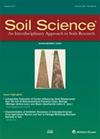Transforming living labs into lighthouses: a promising policy to achieve land-related sustainable development
4区 农林科学
Q2 Agricultural and Biological Sciences
引用次数: 5
Abstract
Abstract. The previous rather abstract debate about sustainable development has been focused by the introduction of the United Nations (UN) Sustainable Development Goals (SDGs) in 2015 and the related European Union (EU) Green Deal (GD) in 2019. Restricting attention to agriculture, proposed targets and indicators are, however, not specific enough to allow a focus for developing innovative and sustainable management practices. Clarity is needed because farmers are suspicious of governmental actions. To confront these problems, the European Commission (EC) has presented the Mission concept that requires joint learning between farmers, scientists and citizens. For the soil mission, “living labs” are proposed that should evolve into “lighthouses” when environmental thresholds for each of at least six land-related ecosystem services are met. This presents “wicked” problems that can be “tamed” by measuring indicators for ecosystem services that are associated with the land-related SDGs in a given living lab. Thresholds with a character that is occasionally regional are needed to separate the “good” from the “not yet good enough”. Contributions by the soil to ecosystem services can be expressed by assessing soil health. By introducing the mission concept, the policy arena challenges the research community to rise to the occasion by developing effective interaction models with farmers and citizens that can be the foundation for innovative and effective environmental rules and regulations. We argue and illustrate with a specific example, that establishing Living Labs can be an important, if not essential, contribution to realizing the lofty goals of the SDGs and the Green Deal as they relate to agriculture.将生活实验室改造成灯塔:实现与土地有关的可持续发展的有希望的政策
摘要2015年联合国(UN)可持续发展目标(sdg)和2019年相关的欧盟(EU)绿色协议(GD)的引入,集中了之前关于可持续发展的相当抽象的辩论。然而,拟议的目标和指标限制了对农业的关注,不够具体,无法将重点放在发展创新和可持续的管理做法上。因为农民对政府的行为持怀疑态度,所以必须明确。为了解决这些问题,欧洲委员会(EC)提出了需要农民、科学家和公民共同学习的使命概念。对于土壤任务,“生活实验室”被提议,当满足至少六种与土地有关的生态系统服务的环境阈值时,它应该演变成“灯塔”。这就提出了一些“邪恶”的问题,这些问题可以通过测量与特定实验室中与土地相关的可持续发展目标相关的生态系统服务指标来“驯服”。有时需要使用带有区域性字符的阈值来区分“好”与“还不够好”。土壤对生态系统服务的贡献可以通过评估土壤健康来表达。通过引入使命概念,政策领域向研究界提出了挑战,要求他们与农民和公民建立有效的互动模式,这些模式可以成为创新和有效的环境规则和法规的基础。我们用一个具体的例子来论证和说明,建立生活实验室对于实现可持续发展目标和绿色协议的崇高目标,即使不是必不可少的,也是重要的贡献,因为它们与农业有关。
本文章由计算机程序翻译,如有差异,请以英文原文为准。
求助全文
约1分钟内获得全文
求助全文
来源期刊

Soil Science
农林科学-土壤科学
CiteScore
2.70
自引率
0.00%
发文量
0
审稿时长
4.4 months
期刊介绍:
Cessation.Soil Science satisfies the professional needs of all scientists and laboratory personnel involved in soil and plant research by publishing primary research reports and critical reviews of basic and applied soil science, especially as it relates to soil and plant studies and general environmental soil science.
Each month, Soil Science presents authoritative research articles from an impressive array of discipline: soil chemistry and biochemistry, physics, fertility and nutrition, soil genesis and morphology, soil microbiology and mineralogy. Of immediate relevance to soil scientists-both industrial and academic-this unique publication also has long-range value for agronomists and environmental scientists.
 求助内容:
求助内容: 应助结果提醒方式:
应助结果提醒方式:


